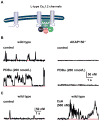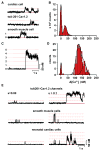CaV1.2 sparklets in heart and vascular smooth muscle
- PMID: 23220157
- PMCID: PMC3678956
- DOI: 10.1016/j.yjmcc.2012.11.018
CaV1.2 sparklets in heart and vascular smooth muscle
Abstract
CaV1.2 sparklets are local elevations in intracellular Ca(2+) ([Ca(2+)]i) resulting from the opening of a single or small cluster of voltage-gated, dihydropyridine-sensitive CaV1.2 channels. Activation of CaV1.2 sparklets is an early event in the signaling cascade that couples membrane depolarization to contraction (i.e., excitation-contraction coupling) in cardiac and arterial smooth muscle. Here, we review recent work on the molecular and biophysical mechanisms that regulate CaV1.2 sparklet activity in these cells. CaV1.2 sparklet activity is tightly regulated by a cohort of protein kinases and phosphatases that are targeted to specific regions of the sarcolemma by the anchoring protein AKAP150. We discuss a model for the local control of Ca(2+) influx via CaV1.2 channels in which a signaling complex formed by AKAP79/150, protein kinase C, protein kinase A, and calcineurin regulates the activity of individual CaV1.2 channels and also facilitates the coordinated activation of small clusters of these channels. This results in amplification of Ca(2+) influx, which strengthens excitation-contraction coupling in cardiac and vascular smooth muscle.
Copyright © 2012. Published by Elsevier Ltd.
Figures





Similar articles
-
Molecular and biophysical mechanisms of Ca2+ sparklets in smooth muscle.J Mol Cell Cardiol. 2009 Oct;47(4):436-44. doi: 10.1016/j.yjmcc.2009.07.008. Epub 2009 Jul 16. J Mol Cell Cardiol. 2009. PMID: 19616004 Free PMC article. Review.
-
Calcium sparklets in arterial smooth muscle.Clin Exp Pharmacol Physiol. 2008 Sep;35(9):1121-6. doi: 10.1111/j.1440-1681.2007.04867.x. Epub 2008 Jan 21. Clin Exp Pharmacol Physiol. 2008. PMID: 18215181 Free PMC article. Review.
-
Calcium sparklets regulate local and global calcium in murine arterial smooth muscle.J Physiol. 2007 Feb 15;579(Pt 1):187-201. doi: 10.1113/jphysiol.2006.124420. Epub 2006 Dec 7. J Physiol. 2007. PMID: 17158168 Free PMC article.
-
Local regulation of L-type Ca²⁺ channel sparklets in arterial smooth muscle.Microcirculation. 2013 May;20(4):290-8. doi: 10.1111/micc.12021. Microcirculation. 2013. PMID: 23116449 Free PMC article. Review.
-
Ca(v)1.3 channels produce persistent calcium sparklets, but Ca(v)1.2 channels are responsible for sparklets in mouse arterial smooth muscle.Am J Physiol Heart Circ Physiol. 2007 Sep;293(3):H1359-70. doi: 10.1152/ajpheart.00450.2007. Epub 2007 May 25. Am J Physiol Heart Circ Physiol. 2007. PMID: 17526649
Cited by
-
PC-PLC/sphingomyelin synthase activity plays a central role in the development of myogenic tone in murine resistance arteries.Am J Physiol Heart Circ Physiol. 2015 Jun 15;308(12):H1517-24. doi: 10.1152/ajpheart.00594.2014. Epub 2015 Apr 17. Am J Physiol Heart Circ Physiol. 2015. PMID: 25888510 Free PMC article.
-
A computational model predicts sex-specific responses to calcium channel blockers in mammalian mesenteric vascular smooth muscle.bioRxiv [Preprint]. 2024 Jan 6:2023.06.24.546394. doi: 10.1101/2023.06.24.546394. bioRxiv. 2024. Update in: Elife. 2024 Feb 09;12:RP90604. doi: 10.7554/eLife.90604. PMID: 37425682 Free PMC article. Updated. Preprint.
-
Mechanisms and physiological implications of cooperative gating of clustered ion channels.Physiol Rev. 2022 Jul 1;102(3):1159-1210. doi: 10.1152/physrev.00022.2021. Epub 2021 Dec 20. Physiol Rev. 2022. PMID: 34927454 Free PMC article. Review.
-
Clustering of CaV 1.3 L-type calcium channels by Shank3.J Neurochem. 2023 Oct;167(1):16-37. doi: 10.1111/jnc.15880. Epub 2023 Jun 30. J Neurochem. 2023. PMID: 37392026 Free PMC article.
-
Calcium Channels in Vascular Smooth Muscle.Adv Pharmacol. 2017;78:49-87. doi: 10.1016/bs.apha.2016.08.002. Epub 2016 Oct 14. Adv Pharmacol. 2017. PMID: 28212803 Free PMC article. Review.
References
-
- Guatimosim S, Dilly K, Santana LF, Saleet Jafri M, Sobie E, Lederer W. Local Ca2+ Signaling and EC Coupling in Heart: Ca2+ Sparks and the Regulation of the [Ca2+]i Transient. Journal of molecular and cellular cardiology. 2002;34:941. - PubMed
-
- Gollasch M, Lohn M, Furstenau M, Nelson MT, Luft FC, Haller H. Ca2+ channels, ‘quantized’ Ca2+ release, and differentiation of myocytes in the cardiovascular system. J Hypertens. 2000;18:989–98. - PubMed
-
- Wang SQ, Song LS, Lakatta EG, Cheng H. Ca2+ signalling between single L-type Ca2+ channels and ryanodine receptors in heart cells. Nature. 2001;410:592–6. - PubMed
Publication types
MeSH terms
Substances
Grants and funding
LinkOut - more resources
Full Text Sources
Other Literature Sources
Miscellaneous

